Science Meets Longevity
I’ve been asking the same question for a long time:
Why do we age, and can we fight it?
This site is my way of chasing the answers and sharing the tools, insights, and science I find along the way.
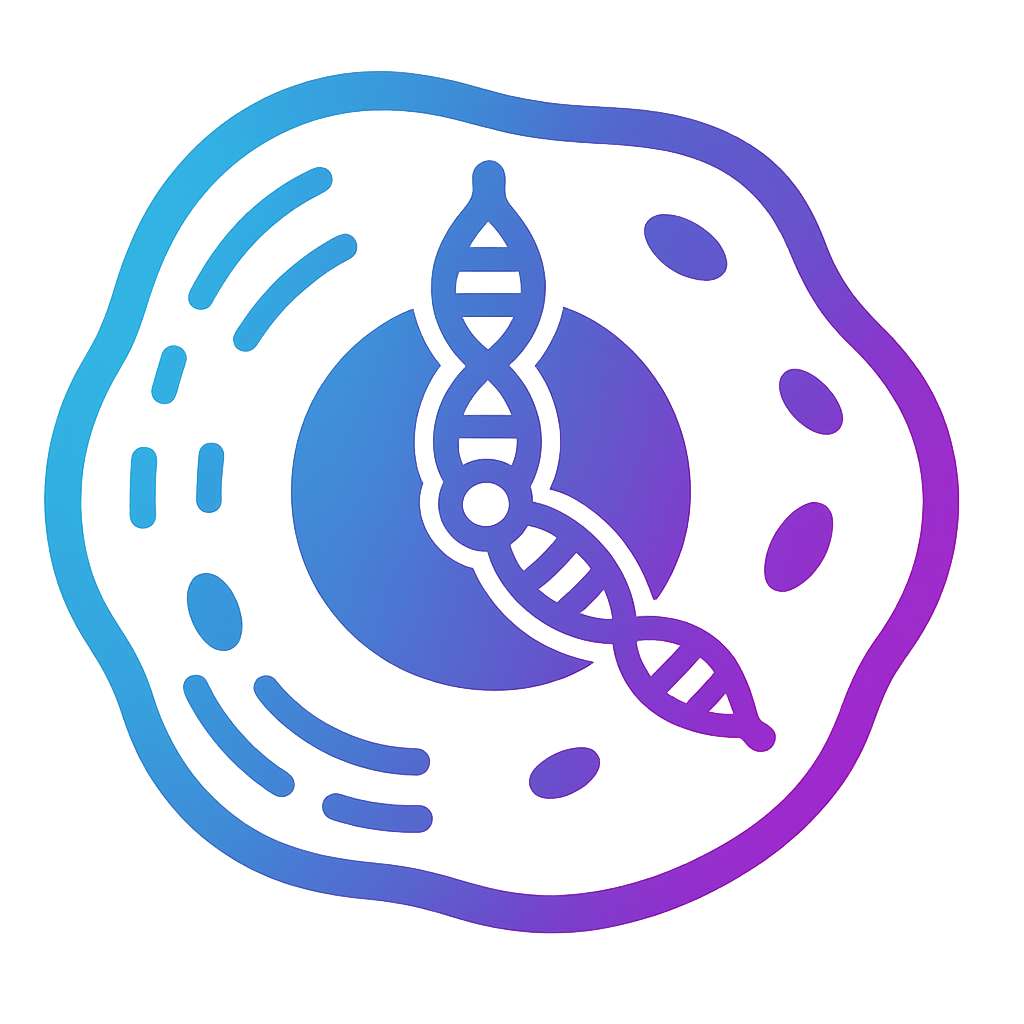
Journey Into the Biology of Time
I’ve been asking the same question for a long time:
Why do we age, and can we fight it?
This site is my way of chasing the answers and sharing the tools, insights, and science I find along the way.

Journey Into the Biology of Time
I’ve been asking the same question for a long time:
Why do we age, and can we fight it?
This site is my way of chasing the answers and sharing the tools, insights, and science I find along the way.

“Those who think they have not time for bodily exercise will sooner or later have to find time for illness.” —Edward Stanley
Hey there, longevity mover.
If you’ve ever wondered how much exercise you really need to slow aging, you’re asking one of the most important health and fitness questions out there. Alongside balanced nutrition and restorative sleep, regular movement may be one of the most powerful anti-aging exercises for longevity, keeping your cells younger, your mind sharper, and your body more resilient.
We’re not just talking about hitting the gym for vanity or counting calories burned. The real magic of exercise comes from its deep biological effects: boosting mitochondrial energy production, improving insulin sensitivity, supporting muscle and bone strength, and triggering repair pathways that keep tissues functioning at their best. This is the kind of workout that keeps your body’s inner machinery running smoothly decade after decade.
Skip regular physical activity, and the signs of decline show up faster. Without enough movement, muscle mass shrinks, inflammation creeps up, cardiovascular health falters, and the brain’s ability to grow new connections slows. In short, exercise is not just about looking fit, it’s your body’s long-term investment plan for a healthier, longer life.
So how much exercise do you really need to turn back the biological clock, and what types of workouts make the biggest difference for longevity? Let’s find out.
If you want to know how much exercise you really need to slow aging, you first need to understand what makes physical activity so biologically powerful. A well-designed workout is not just a way to burn calories, it’s a complete recalibration of your body’s operating systems, like sending every department into high-performance mode at once.
When you exercise, your body experiences short bursts of controlled stress, increased oxygen demand, mechanical strain on muscles, and elevated heart rate. This stimulates a cellular alarm system that switches on powerful repair pathways. Enzymes involved in DNA repair, such as PARP1, become more active, scanning for breaks and oxidative lesions caused by daily life.
Exercise also boosts the expression of antioxidant enzymes like superoxide dismutase and catalase, which neutralize reactive oxygen species before they can damage DNA. Protecting genomic integrity helps slow the hallmark of aging called genomic instability, and indirectly guards against downstream hallmarks like cellular senescence and loss of proteostasis.
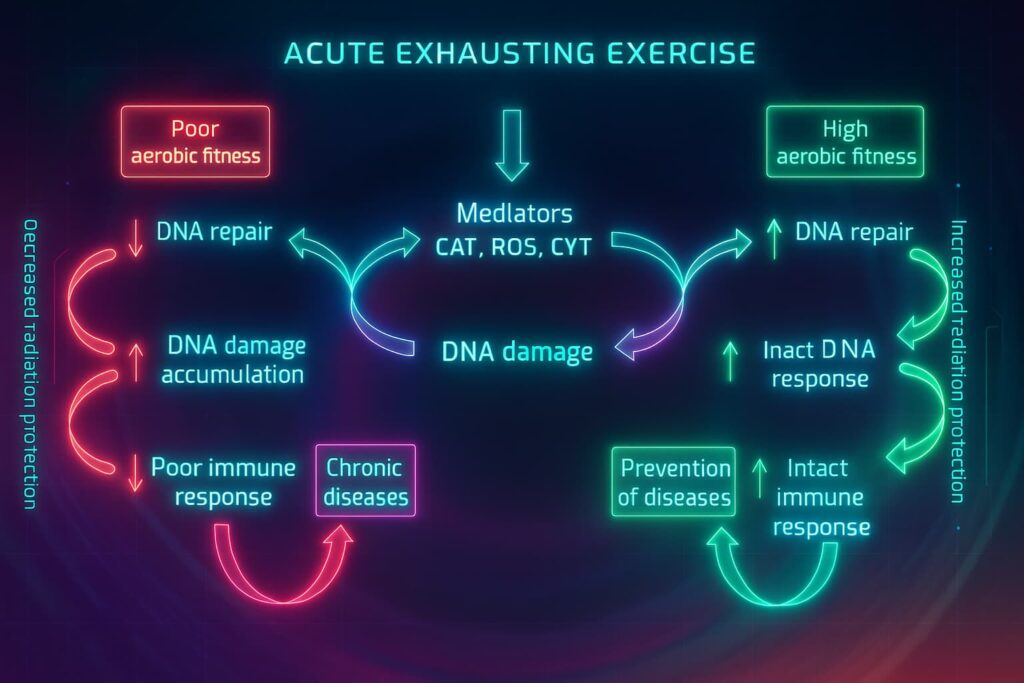
Physical activity is a potent signal for the brain to grow and remodel. Exercise increases blood flow, delivering oxygen and nutrients that support neurogenesis (birth of new neurons) and synaptic plasticity. It also boosts brain-derived neurotrophic factor (BDNF), a molecule that acts like a growth fertilizer for neurons.
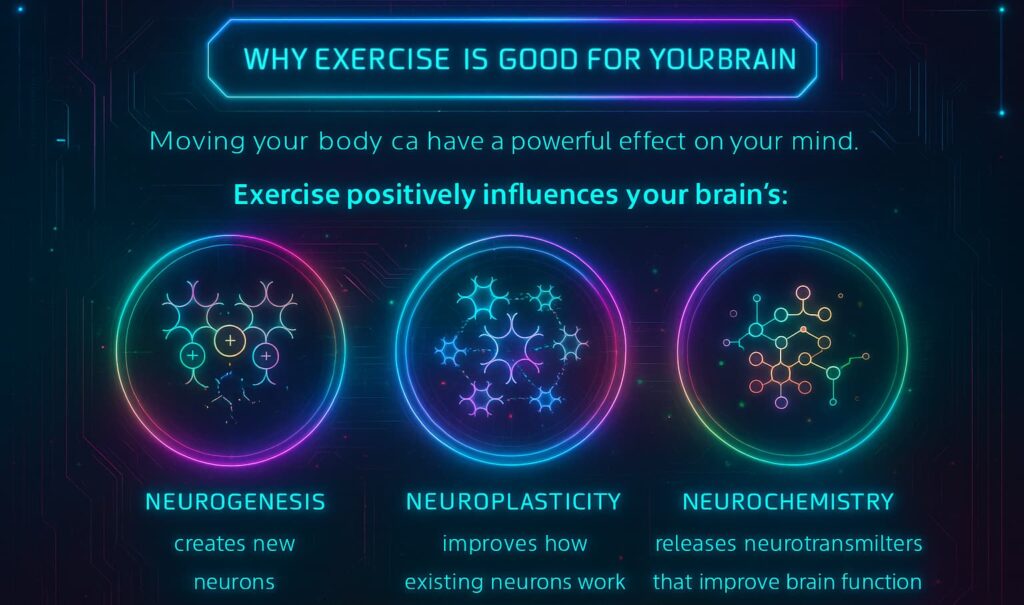
This neuroprotective effect helps counter age-related declines linked to altered intercellular communication and mitochondrial dysfunction in brain cells. Regular aerobic movement also improves the brain’s ability to clear metabolic waste, further lowering the risk of cognitive decline.
Exercise (especially resistance training) triggers a surge in growth hormone and testosterone, both of which are essential for muscle repair, collagen synthesis, and bone density maintenance. These hormonal shifts also signal stem cells within muscles and other tissues to activate, dividing and differentiating to replace damaged cells.
By supporting stem cell activity, exercise directly combats the hallmark of aging known as stem cell exhaustion, while simultaneously protecting against mitochondrial dysfunction through enhanced energy production.
Movement is one of the most effective natural anti-inflammatories. Moderate-intensity exercise prompts immune cells to release anti-inflammatory cytokines like IL-10, while reducing the chronic, low-grade inflammation driven by IL-6 and TNF-alpha.
This immune recalibration helps protect against the hallmark of aging called chronic inflammation and supports a healthier gut microbiome by improving circulation to the digestive tract and balancing immune responses in the gut lining.
Skipping regular movement is not just about feeling sluggish or losing a bit of muscle tone. Missing out on consistent physical activity creates a biological chain reaction that accelerates several hallmarks of aging at the same time. If you have ever wondered how much exercise you need to stay healthy or questioned whether daily workouts really matter, the science on exercise and aging is clear: inactivity robs your body of essential maintenance signals. It is a sign to review your health and fitness habits and commit to exercise routines designed for workout and longevity.
Without the mild stress that comes from exercise, your cells miss one of their most powerful triggers for DNA repair. Genomic instability worsens because repair enzymes remain less active, leaving strand breaks and oxidative lesions unrepaired. Over time, these errors push cells toward cellular senescence, where they stop dividing but continue releasing inflammatory molecules. Building regular workouts into your week, especially anti-aging exercises for longevity, ensures these repair pathways stay switched on and supports overall exercise to slow aging.
Exercise is a primary driver of mitochondrial biogenesis, the creation of new, healthy mitochondria. Without it, your existing mitochondria age faster, producing less energy and more reactive oxygen species. This energy shortfall slows tissue repair, weakens muscles, and leaves the brain more vulnerable to fatigue. Anti-aging exercises for longevity keep your cellular power plants running at full capacity, helping maintain both health and fitness while supporting workout and longevity goals.
Illustration idea: The effect of regular exercise on mitochondrial health, showing increased energy output and reduced oxidative stress, linked to health and fitness, exercise and aging, and workout and longevity.
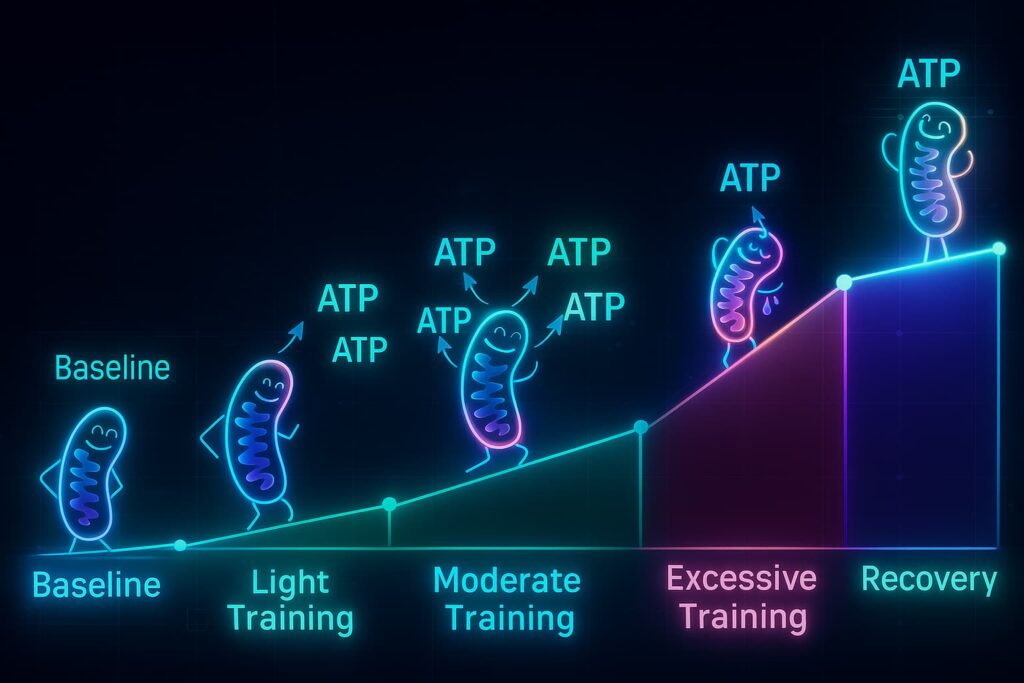
Lack of exercise tilts the immune system toward a pro-inflammatory state, increasing IL-6 and TNF-alpha levels. This low-grade chronic inflammation, also known as inflammaging, accelerates cardiovascular decline, disrupts gut microbiome balance (dysbiosis), and damages connective tissues. Even moderate physical activity can recalibrate immune responses, improve health and fitness, and play a major role in exercise to slow aging.
Graphic idea: The effect of exercise on inflammation reduction, improving immune balance and supporting workout and longevity.
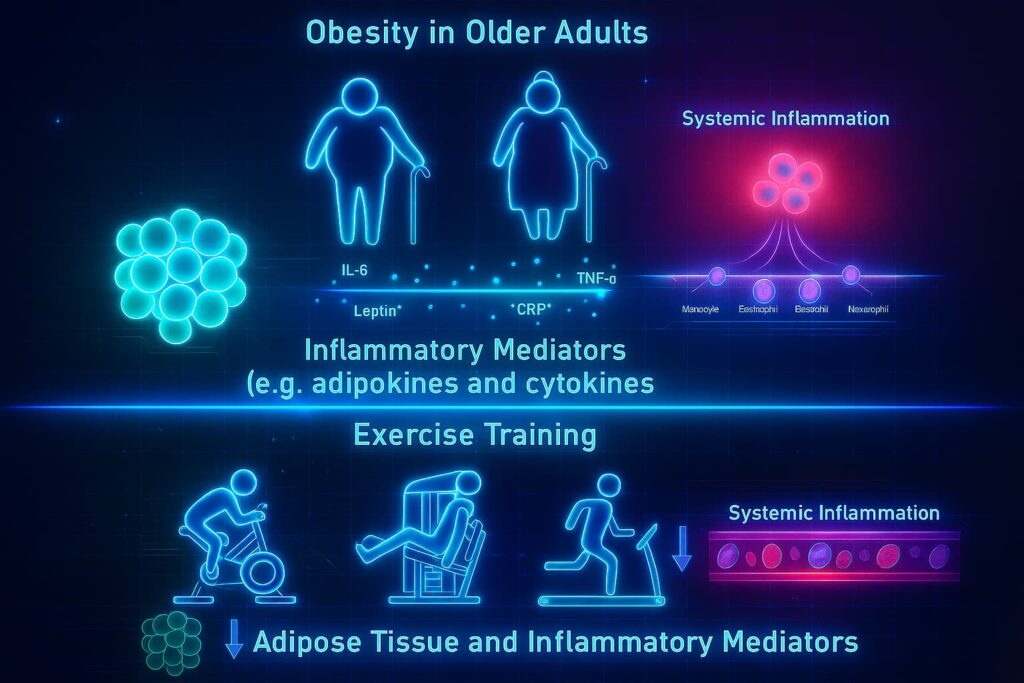
Without regular physical activity, the pulses of growth hormone, testosterone, and other anabolic signals diminish. This slows collagen production, muscle repair, and fat metabolism. Over time, reduced hormonal signaling contributes to stem cell exhaustion, since the cues that keep stem cells active are weakened. Consistent anti-aging exercises for longevity help keep these regenerative signals strong, improving both exercise and aging outcomes.
Exercise boosts blood flow and releases growth factors like BDNF that protect neurons and stimulate new connections. Without these stimuli, the brain’s repair and plasticity slow down, tying into the hallmark of aging called altered intercellular communication. This can increase the risk of cognitive decline and neurodegenerative diseases. A regular workout for longevity helps maintain sharp mental performance alongside physical health.
In short, skipping exercise is like never servicing a high-performance vehicle. It may still run for a while, but the unseen wear compounds until the breakdowns are unavoidable. Focusing on health and fitness through consistent exercise to slow aging is one of the most powerful strategies for lifelong vitality.
Exercise is like the premium maintenance package for your body and brain. In youth, regular movement activates a full range of repair and rejuvenation systems every time you work out. With age, that package often gets cut back. Many people in their 60s or 70s have lower muscle mass, reduced cardiovascular capacity, and slower recovery compared to their 20s. This decline is not because the body no longer benefits from exercise. It is because several systems that respond to exercise become less sensitive, and the loss of activity further weakens those same systems, creating a self-reinforcing cycle. If you know how much exercise you need and stick to consistent health and fitness habits, you can help slow this decline and improve exercise and aging outcomes.
When you are young, even light to moderate exercise sends strong signals for adaptation. Muscle fibers respond by growing stronger, mitochondria multiply, and DNA repair enzymes become more active. With age, the sensitivity of these pathways declines. Fewer repair signals mean smaller gains from each workout. Less exercise then weakens these systems even more, making it harder to maintain strength, endurance, and recovery. Consistent training with anti-aging exercises for longevity helps keep these repair networks responsive and supports workout and longevity benefits.
Hormones like growth hormone, testosterone, and estrogen play a key role in muscle building, collagen synthesis, and tissue repair. As we age, levels of these hormones naturally drop, which slows recovery and reduces the benefits of training. At the same time, reduced activity lowers the stimulus for hormone release, creating a cycle of loss. Resistance training, interval workouts, and adequate recovery can help maintain more youthful hormone patterns, supporting health and fitness and promoting exercise to slow aging.
Chart idea: Changes in growth hormone and testosterone with age, and how regular exercise helps sustain healthy levels, linked to health and fitness, exercise and aging, and workout and longevity.
Exercise encourages your cells to build more mitochondria and improve their efficiency. With age, the ability to trigger this adaptation weakens. Mitochondria become fewer, less efficient, and more prone to oxidative damage. This means slower energy production, reduced stamina, and greater fatigue. Regular activity, especially aerobic and high-intensity training, helps preserve mitochondrial health and function. Anti-aging exercises for longevity directly protect against mitochondrial dysfunction and are a core part of exercise to slow aging.
Older adults often experience slower healing after workouts due to changes in connective tissue, lower stem cell activity, and increased inflammation. This can lead to longer breaks between training sessions, which reduces consistency and causes further losses in strength and endurance. A balanced program that includes strength training, mobility work, and active recovery days can minimize these setbacks and maintain workout and longevity benefits over time.
Aging is associated with higher baseline inflammation and a gradual decline in muscle tissue, known as sarcopenia. Chronic inflammation interferes with muscle repair, weakens immune balance, and reduces exercise tolerance. Without regular movement, inflammation increases further, accelerating the loss of muscle mass and strength. Anti-aging exercises for longevity, combined with consistent health and fitness routines, reduce inflammation and help preserve muscle for long-term exercise and aging health.
The same biological changes that make exercise adaptations harder, including hormonal decline, reduced mitochondrial responsiveness, lower repair signaling, inflammation, and muscle loss, are also worsened by inactivity. This feedback loop feeds directly into the hallmarks of aging. Less activity increases genomic instability, mitochondrial dysfunction, chronic inflammation, stem cell exhaustion, and loss of proteostasis. In turn, these hallmarks make it harder for the body to respond positively to training, creating a vicious cycle that speeds up biological aging.
The takeaway is simple. Protecting your fitness is not just about looking good or staying active. It is about breaking this cycle so that the systems that keep you healthy and youthful can continue to function at their best. Prioritizing health and fitness through consistent exercise to slow aging and targeted workout and longevity strategies is one of the most effective ways to maintain vitality for decades.
Knowing how much exercise you need is only half the story. The real challenge is doing it consistently, week after week, so your body can switch into repair mode, recharge its systems, and defend itself against the hallmarks of aging. Think of exercise as the day shift in your body’s factory, the time when builders, electricians, and engineers show up to reinforce structures, upgrade machinery, and strengthen the wiring that keeps everything running for years to come. Here is how to make sure they get the job done.
Your body thrives on rhythm. Just like the factory runs best when shifts are predictable, your repair and adaptation systems need regular exercise to know when to get to work. Training at consistent times keeps your hormonal patterns steady and ensures DNA repair enzymes, antioxidant defenses, and mitochondrial growth are activated reliably. Miss workouts often and it is like asking your crew to come in on random days. The work piles up, and efficiency drops.
Muscle is one of the most important assets for longevity. Strength training tells your body to preserve and build lean tissue, stimulates bone density, and releases growth factors that protect against stem cell exhaustion. Think of it as reinforcing the factory’s walls and pillars so they can hold up under decades of wear. Without it, structural decline accelerates, making every other repair job harder.
Aerobic exercise like brisk walking, cycling, or swimming acts like an energy systems upgrade for your factory. It expands your network of mitochondria, improves their efficiency, and reduces oxidative stress. This directly protects against mitochondrial dysfunction, keeping your power plants running clean and strong. A mix of moderate and higher-intensity sessions works best for long-term adaptability.
Repairs do not happen during the workout, they happen afterward. Recovery days are when your muscles rebuild, mitochondria multiply, and inflammation settles. Skipping recovery is like running the factory machinery nonstop until it overheats and breaks down. Active recovery methods such as stretching, yoga, or light walking keep circulation moving without adding strain.
Your repair crews need quality materials. A nutrient-dense diet with adequate protein supports muscle repair, while antioxidants from fruits and vegetables help neutralize exercise-induced oxidative stress before it damages DNA or proteins. Skipping fuel or relying on low-quality food is like handing your builders warped wood and rusty nails.
Cortisol rises during intense exercise, but it should drop back down afterward. If life stress keeps it elevated, inflammation lingers and recovery slows. It is like trying to repair the factory while the fire alarm is still blaring. Techniques such as breathwork, mindfulness, and adequate post-workout nutrition help switch the body into repair mode.
Some supplements can act like extra tools for your repair team. Creatine supports muscle energy, omega-3s reduce inflammation, and NAD+ precursors may enhance mitochondrial function. Just like in the factory, tools only work when the workers know how to use them, so pair supplements with consistent training and recovery habits for the best results.
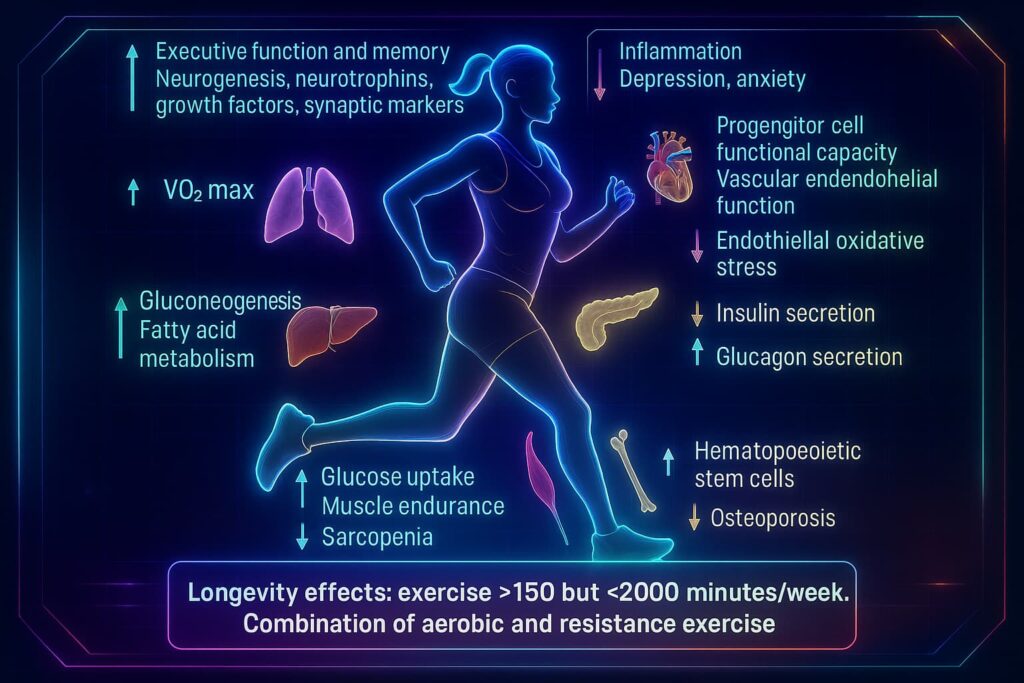
If you have ever asked yourself how much exercise you need to slow aging, the answer is simple: enough to let your body’s repair crews finish their work. Exercise is not just about burning calories or building muscle, it is when your DNA protection systems switch on, your mitochondria multiply, your hormones signal renewal, and your immune system recalibrates.
Neglect it and you accelerate multiple hallmarks of aging at once, from genomic instability and cellular senescence to mitochondrial dysfunction, chronic inflammation, and stem cell exhaustion. Protect it and you give your body the signals and support it needs to slow the biological clock.
The beauty of exercise is that it is free, adaptable to any fitness level, and completely under your control. Whether you are fine-tuning your health and fitness habits, adding anti-aging exercises for longevity, or simply moving more throughout the day, the payoff is a body and mind that grow stronger, sharper, and more resilient over time.
So tomorrow, think of your workout as a high-performance upgrade session, the gym or track as your workshop, and yourself as the priceless machine being enhanced. Give your repair crew the movement, fuel, and recovery they need, and they will keep you running strong for decades to come.